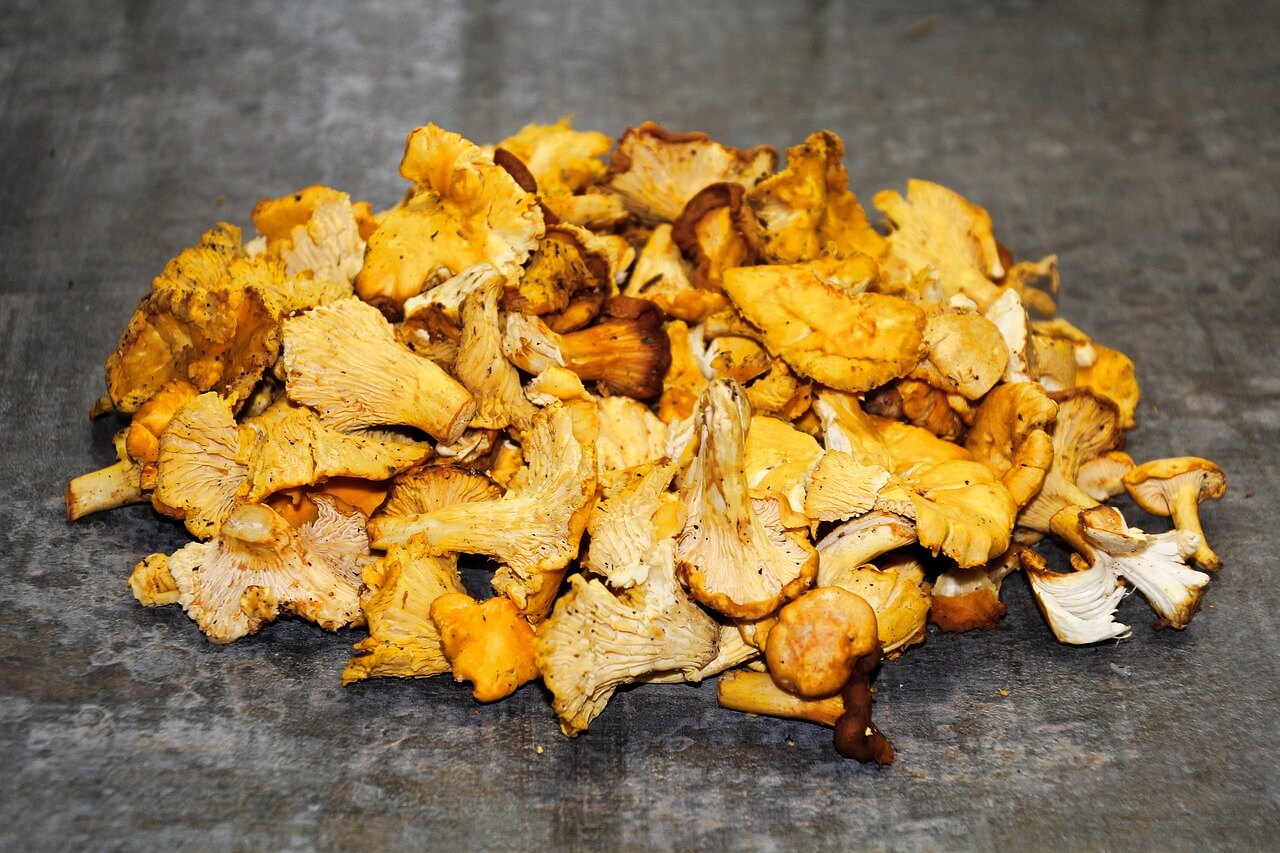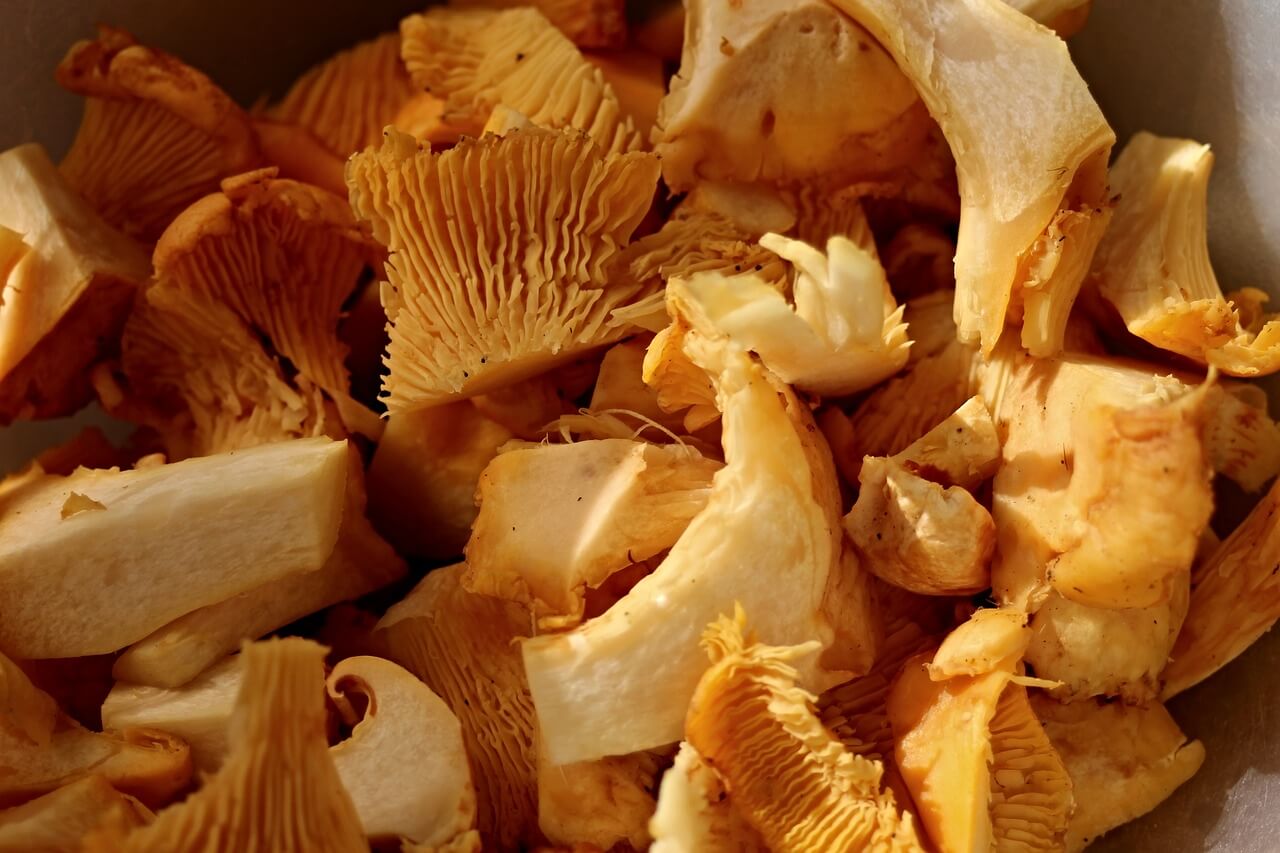You’ve just returned from harvesting a basket load of chanterelles; now what are you supposed to do? Chanterelle mushrooms are enjoyed throughout the world in many different kinds of dishes. If you’re wondering how to cook wild chanterelle mushrooms, you’ve come to the right place. Let’s take a closer look at what you can make with chanterelle mushrooms, some basic ways to prepare them, and some recipes you may want to try.
What You'll Learn Today
What to Make With Chanterelle Mushrooms

Chanterelle mushrooms have a mildly fruity, peppery flavor that goes well in many different dishes. Whatever your go-to meal may be, you can probably find a recipe that utilizes chanterelles.
These mushrooms pair well with pasta. Throw them in a cold or hot pasta salad, throw them in a stir-fry, or saute them as the perfect side dish to go with spaghetti.
In some parts of the country, chanterelles tend to appear during the fall and winter. They make a wonderful addition to soups and stews, can be added to Thanksgiving and Christmas stuffings, and can be cooked and pureed to make a sauce.
If you’re feeling ambitious, you can pickle or dehydrate your chanterelles for future use. Some people may eat them raw, but most prefer them cooked.
For a quick, easy chanterelle snack or side dish, you can simply throw them in a saucepan with a bit of oil and saute them for a few minutes. Or you can spend a bit more time and effort and add them to dishes such as brie pastries and baked fondue.
As you can see, the possibilities really are endless!
How to Prepare Chanterelle Mushrooms

There are many different ways to prepare chanterelles. In this section, we’ll take a look at some basic steps for some of the most popular preparation methods: sauteing, baking, and dehydrating.
To Saute
- Preheat a saucepan over medium-high heat. Add enough oil to coat the bottom of the pan.
- Wash your chanterelles thoroughly, being careful not to damage them. Decide whether to slice them, dice them, or cook them whole–any method will work.
- Dry them thoroughly after washing, then add them to your preheated saucepan. Stir or toss lightly to coat all of the mushrooms with oil.
- Adjust heat as necessary so the mushrooms cook quickly but the oil doesn’t splatter. Stir or toss every 1 to 2 minutes.
- Cook until the mushrooms are tender but not mushy, about 3 to 5 minutes. Immediately remove them from the heat, add desired seasonings, and enjoy!
To Bake
- Preheat your oven to 400 degrees. Wash and dry the chanterelles as noted above.
- Place the mushrooms on a cookie sheet or in a shallow baking dish. There is no need to spread them out too thinly, but make sure they are in a single layer.
- Drizzle olive oil and spices over the mushrooms and stir to coat evenly. There should be just enough oil to coat them without leaving puddles of oil in the pan.
- Bake the chanterelles until they’re tender but not mushy, about 10 to 15 minutes. If you want, you can leave them a few minutes longer until they begin to brown at the edges.
- Remove them from the oven. You can serve them immediately or allow them to sit up to a few hours if you’d prefer to serve them room temperature or cold.
To Dehydrate
- Wash and dry the mushrooms, making sure not to allow them to soak up too much water. Mushrooms are like sponges, and the more water they take in during cleaning, the longer they will take to dehydrate.
- Slice the mushrooms from top to bottom so each piece is about ¼ of an inch thick. If the mushrooms are small enough, there is no need to slice them at all.
- Place the mushrooms and mushroom pieces on dehydrator trays or racks. For the sake of air flow and even drying, make sure the pieces are in a single layer and are not touching each other.
- Place the trays in the dehydrator and set the desired dehydrating temperature. It might be best to double check with your owner’s manual if you’re not sure what temperature setting to use.
- A good “middle ground” temperature for dehydrating chanterelles is 125 degrees. That said, some people set their dehydrators as low as 105 degrees, while others go as high as 160 degrees.
- If you set your temperature for 125 degrees, your mushrooms will take at least 4 to 6 hours to become sufficiently dehydrated. The higher the temperature, the shorter the dehydration time.
- Check your mushrooms every couple of hours to see how they are getting on. Remove them from the dehydrator when they feel leathery to touch and snap when you squeeze them between your fingers.
- After they have cooled a bit, place the chanterelles in a food storage bag or airtight container. They will store at room temperature for up to several years.
For a visual tutorial on the process of dehydrating chanterelles, check out the video below.
Chanterelle Mushroom Recipes
So, now you know the basics – you have a general understanding of how to prepare chanterelle mushrooms. But what if you’re looking for something more specific?
Check out this list of top chanterelle mushroom recipes from around the internet:
- Chanterelle mushroom pasta: this flavorful recipe is the perfect blend of creamy, earthy, and filling.
- Pickled chanterelle mushrooms: Looking for a different way to preserve your mushrooms? This recipe produces firm, tart pickles that will keep you coming back for more.
- Best ever wild mushroom risotto: This recipe is surprisingly easy to make and gives you a filling dish that works well as either a side or a vegetarian main dish.
- Chanterelle mushroom chowder: This great cold weather recipe combines chanterelles, corn, and crab meat for a truly unique blend of flavors.
- Chanterelle mushroom crostini with ricotta: This fun recipe makes a perfect snack, lunch, or side dish for just about any occasion.
Conclusion
Chanterelle mushrooms have a wide variety of uses and add a unique flair to many different recipes. Whether you saute and eat them plain, pickle them, or add them to your favorite soup or pasta recipe, you really can’t go wrong with these flavor-pack mushrooms.
Chanterelle mushrooms are also good for many soup recipes. Try it!